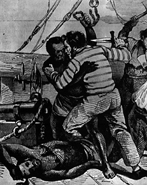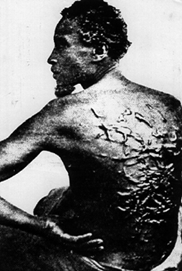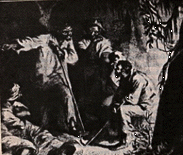
 The Maafa:
The Maafa:
A Holocaust of Greed

The term Maafa is kiswahili for "disaster" or "terrible occurrence, and thus the name now given to the Trans Atlantic Slave Trade. The Trans Atlantic Slave Trade is probably the most horrendous and traumatic event in the Western hemisphere. To the descendants of Africans now residing in North America, South America, and the Caribbean, it is definitely the most significant event in our history. The Trans Atlantic Slave Trade is born out of greed. With the "discovery" of the New World, Europe saw the probability of amassing large amounts of wealth unknown to the region at that time. For the labor needed to collect this wealth gained from gold, silver, sugar, tobacco and other crops, Europeans went to the shores of Africa. For years the Europeans had traded with the Africans for crops and other items. But now they came for human bodies. The ensuing trade turned portions of the African continent into chaos, empires rising and falling based on their quota of slaves. The brutalities and degradation these victims existed under was daily and never-ending. And the legacy would continue to their children and descendants for generations to come. This was the Trans Atlantic Slave Trade: an event which destroyed peoples and whole cultures; an event which would destabilize a continent, changing it forever; an event which would enrich Europe, create empires, and build America. |
The Slave Trade was not a statistic...The Slave Trade was people living, lying, stealing, murdering, dying.
The Slave Trade was a Black mother suffocating her new-born baby because she didn't want him to grow up to be a slave.
The Slave Trade was a "kind" captain forcing his suicide minded passengers to eat by breaking their teeth...
The Slave Trade was a pious captain holding prayer services twice a day on his slave ship and writing later the famous hymn: "How Sweet the Name of Jesus Sounds."
Lerone Bennet, Before the Mayflower

Who Traded?
Given its profitable nature, it is not surprising that nearly EVERYONE was involved in the Trans Atlantic Slave Trade. Europeans would play the most significant role in the trade as they were the buyers and thus exercised the greatest amount of control. Europeans of various nationalities, status and religions engaged in slavery. This included the Spanish and the French, royalty and merchants, Catholics and Jews. Arabs, as in the East, played a significant role in the Trans Atlantic Slave Trade. They raided many African villages and were key intermediaries between Europeans and Africans. |
The African Role in the Slave Trade
The issue of African involvement in the Trans Atlantic Slave Trade is a complex one. First it must be understood that, as with the rest of the world, slavery had long existed in Africa. The form it took however differed in various respects from its European counterpart. Slavery in Africa was a product of warfare in which the conquered were expected to become servants to the victors. Or it may have been a form of punishment for crime, taboo breaking, etc. There was certainly some level of cruelty as servitude demands such. Yet these captives were never treated as entirely sub-human beings. There were many cases of slaves marrying into the households which held them. Prior to European contact, a point at which the African system of slavery changed drastically, slavery was never the economic base of any African society. And it did not so fully deny anyone their humanity as European chattel slavery would do. |
The Arabic technique of "divide and conquer" was mastered by Europeans. They would give one group of Africans guns to raid another for slaves. They would then arm another to do the same and yet another to help them protect themselves from other African slavers. If one wanted guns to protect one's self from slavers, one was forced to become a slaver also. This vicious cycle of bodies-for-guns-or -protection, spread like a disease. Some Africans, such as those of Dahomey, prospered immensely from slave trading. Slaves could be bartered for anything from glass trinkets to rum and whiskey. Especially traded, were guns. This greed on the part of Africans was key in their participation in the trade.
|
It must be understood that there was no unifying "racial" identity of the period between diverse African ethnic groups. Making slaves of captives of war seemed "natural." And the participants were mostly royalty and slave warrior groups. Only in the rarest circumstance did Africans actually raid their own villages for slaves. Most came from other ethnic groups as the product of war. It should also be remembered that many of those who participated in the trade often became slaves themselves. Ethnic warfare and chaos was needed continually to keep the trade alive. Africans owned no ships to transport the cargo of human bodies, no factories to manufacture guns and no large plantations to be operated by slaves. In essence had there been no need for slaves by Europe and her colonies, there would have been no slave trade. States such as Ashanti, Dahomey, Bambara and many others grew powerful from slave trading. This era of greed on the part of Africa's ruling class would cost it dearly in the end. In the end it was Africa which was left weakened and disunited and Europe who prospered. As one historian has said, "Europeans did not come for the Ibo, Mandingo or Yoruba---they came for us all." |

Capture and the Slave Dungeons
 | European slavers and their African allies raided the Western coast of Africa with guns and cannons, setting fire to towns and villages. Women caught in these raids were usually sexually abused through rapes: public or private, gang or individual. This act of disempowerment served a dual purpose: to strip African women of any dignity and to force African men to watch as their sisters, daughters, wives, aunts, grandmothers and friends suffered while they stood by powerless. Children, male or female, endured the worst sexual abuse often leaving them bleeding to death or in a state of permanent shock. European diseases such as syphilis and gonorrhea were often passed on to these victims. Captured and bound with ropes, nets, wood, iron, leather or other bindings, the Africans would then set upon a torturous march to the coast where many died along the way. |
 | If they survived the death march to the coast, the dungeons would be the next stop for these captive Africans. Here they were packed into small dirt-floored shacks known as baracoons which held 30 to 50 Africans within a 10 by 15 ft floorspace covered with vomit, urine, feces and blood. Day and night the temperature within the cell was well over 90 degrees. Dehydration through diarrhea, vomiting and sweating was a common form of death. Here Africans were also branded with hot irons. In such unsanitary conditions, the burns often became infected inducing fevers or gangrene. These hapless victims were clubbed, whipped or shot to death as a warning to other Africans to remain in good health. African women, as would become the routine, were raped repeatedly thus creating a host of unwanted pregnancies. The ground in the women's baracoons was said to often be littered with menstrual blood and aborted fetuses. Pictured here is the infamous slave dungeon of El Emina in Ghana. Hundreds of thousands of Africans died in these dungeons waiting, sometimes for months, to be transported through "the door of no return." |

The Middle Passage

Jesus, the Liberty, and the Gift of God were some of the ships which dealt in human misery. Africans were brought aboard the ship near, if not fully, naked. Every space available was utilized for holding the human cargo who remained chained to each other. As Eric Willams put it, "Each slave had less room than a man in a coffin." The floor was filled with blood, human waste, parasites and vomit. The air was no better as decaying bodies and human excrement filled the nostrils, often causing suffocation. Parasites such as lice infested dirt matted hair while maggots lived within open sores. Many Africans went insane in this seemingly never-ending nightmare. For African women there was no rest as sexual abuse by the ship's crew was an ever present threat. |
 | Death on these ships came in a variety of ways. Sometimes it came in the cells where disease and suffocation would finally take its toll. Sometimes it was the product of repeated rapes which women, men and boys were forced to endure. Some Africans were thrown overboard, half-alive, to be drowned or devoured by sharks who had learned that the slave ships often dispensed a feast of Black bodies. One slave captain, short on food, had 132 Africans thrown overboard because his insurance covered death by drowning but not starvation. Others still, tired of the rapes, beatings and abuse, jumped eagerly into the waters to escape the madness about them. |
 | Resistance and insurrection were daily thoughts on the captured Africans' and fearful ship captain's minds. Some, such as the famed Amistad Revolt, were successful. But the price of failure was harsh. For women it was gang rape preceded or followed by a flogging. Others were slashed with knives, slit from stomach to vagina. Men were often castrated and mutilated or in one known case, made to rip out and then devour the heart, liver or other organs of their comrades. It was common to make the remaining Africans---men, women and children--- watch these gory spectacles. |
How many Africans died in route to the new world? Some say hundreds of thousands or perhaps millions of African bodies may litter the Atlantic sea floor.

Arrival: "The New World"
 | After enduring the horrors of the slave ships, the Africans were then sold and auctioned off, along with livestock, to the highest bidder. Some were sold in the Caribbean, some in South America, some in North America, and others in Europe. All were slaves. (About 49% of all slaves in the Western hemisphere went to South America; 38% went to the Caribbean; a little over 7% went to Mexico and Central America; 4.5% ended up in the United States.) |
 | Life in the new world was harsh for these recently arrived Africans. They were made to complete all types of tasks: from domestics to field hands. Black bodies were whipped, beaten, raped, mutilated, castrated, or worked to death in this strange new land. One terrible account tells of a slave master who nailed a Black woman to a tree by her ear for breaking a dish. |
 | Throughout all of this resistance was common. Many Africans, such as the famous Maroons of the Caribbean and South America, often revolted and escaped into the hillsides. Their courageous raids were a constant thorn in the plantation owner's side. These rebellions would create the Gabriel Prossers, Denmark Vesseys, and Touissant L'Overtures. But revolt was costly. Unless complete freedom was won, as in the case of Haiti, revolts were suppressed brutally. In Santa Domingo there is the account of a large group of rebels being buried alive. The vast majority attempted to resist in any manner they could. But mostly they attempted to survive as Ogun and Oshun were replaced with Mary and Jesus, and Asante, Shakur, and Adun were replaced with John, Elizabeth and Tom. And the horror and humiliation would continue for centuries, endured by one's children and their descendants. Pictured here is an artist's recreation of the plotting of the famed Nat Turner Revolt. |
Holocaust: The Numbers
The numbers for this Holocaust are unknown as many documents were falsified by smugglers and ship captains. The numbers however are well into the millions. The most moderate count places 24 million Africans being smuggled into the New World. Half of them would die en route. Others go as high as to claim 40 million Africans imported.
|
The Impact of Slavery on Africa's Population
To put things into perspective, let us take a look at scholar Walter Rodney's statistics on African population growth during the trans-Atlantic slave trade period. Africa's population growth between 1650 and 1900 went from 100 million to a mere 120 million. If compared with the rate of growth of Europe and Asia, Africa should have held some 400 million. What was the cause of this comparatively low rise in population? What is the cause of the missing 280 million missing men, women and children? Does the answer lie in the slave trade? Does this fantastic number include those who were never born because of the slave trade? What percentage of this vast number were those snatched from the continent? How many in this number were killed in ethnic-slave trade based warfare before they could contribute to Africa's population growth? The answers to these questions remain mostly unanswered. But the very effects of the slave trade on African life seems staggering given the numbers.(Photos and Information courtesy of The Black Holocaust for Beginners by SE Anderson, A Pictorial History of the Slave Trade, Capitalism and Slavery by Eric Williams, Slave Women in Caribbean Society by Barbara Bush, The Black Man's Burden by ED Morel, How Europe Underdeveloped Africa by Walter Rodney and Black Jacobins by Cyril James ) |


 The Maafa:
The Maafa: 











